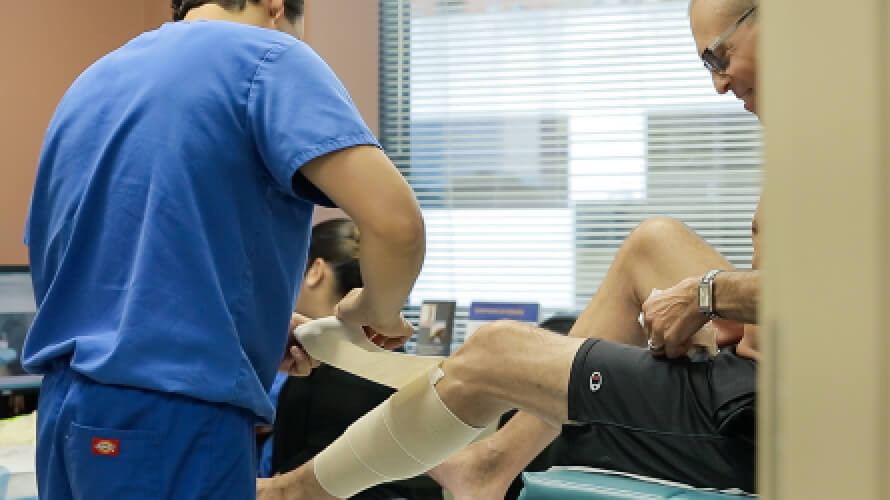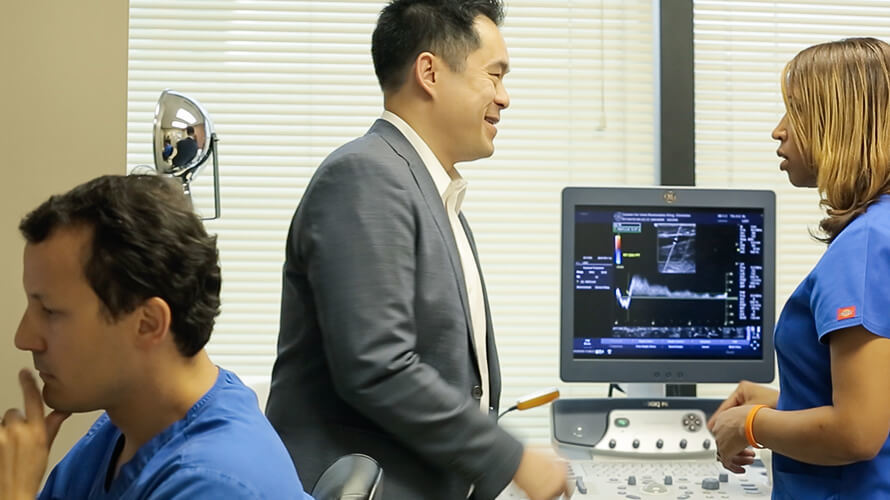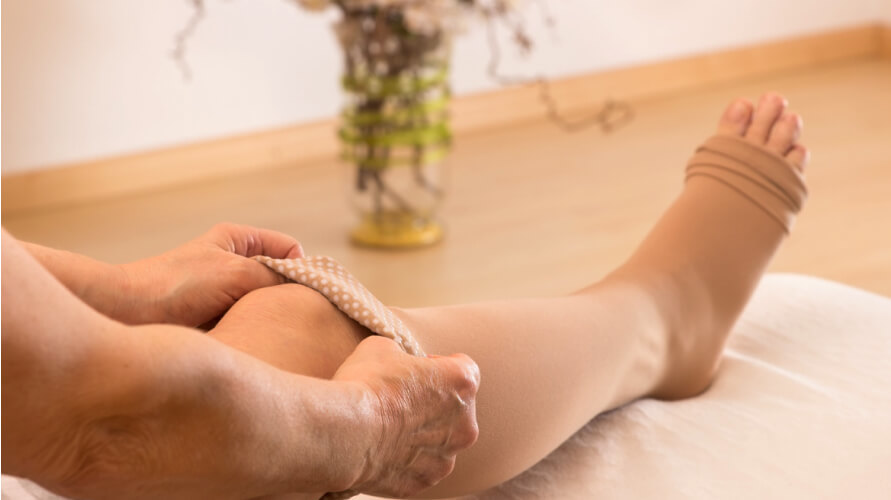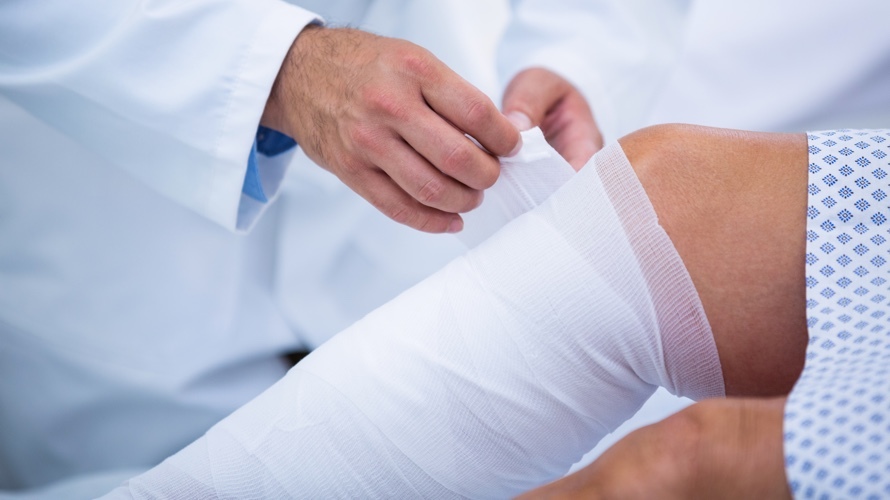Spider Veins: Causes, Symptoms, and Treatment
Imagine a Life Free from Spider Veins and Leg Discomfort
Don't let spider veins disrupt your lifestyle. Relief from the discomfort of spider vein pain and symptoms, including the unsightly weblike networks of blood vessels on the surface of the skin of your leg, is possible. Our expert leg vein solutions are tailored to target and treat leg issues related to problem veins in your legs—helping you regain confidence and comfort. Say goodbye to spider vein pain and hello to restored leg health. Your journey towards healthier, pain-free legs begins today.
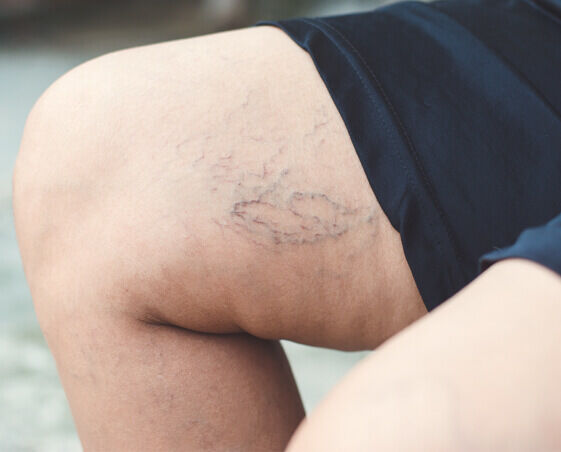
Vein Care Treatment: Post Procedure
Congratulations! Your spider vein treatment day has arrived! For most individuals, it comes with excitement and anticipation—and for some, a little nervousness, too. For most people, the prospect of healthy legs and the improved confidence of wearing shorts or dresses makes it all worthwhile.
Knowing that you're in the best hands in vein care today at Center for Vein Restoration can put your mind at ease. Our vein physicians are highly trained and board-certified experts in vein treatment. Our staff strives to maintain a friendly, comfortable atmosphere, helping ease any jitters and making your journey toward healthy, beautiful legs a positive experience.
Immediately following spider vein treatment
After your spider vein treatment, proper post-procedure care is essential for optimal healing and results. Please consider the following:
- You may be advised to wear compression stockings to aid in circulation and reduce swelling.
- Regular walking can help maintain healthy blood flow.
- Avoid prolonged sun exposure, and use sunscreen on treated areas to safeguard against skin damage.
- Light activities are encouraged, but strenuous exercises should be avoided immediately following the procedure.
Keeping the treated area clean and following specific instructions from your Center for Vein Restoration provider is crucial. Regular follow-up appointments allow your vein doctor to monitor your progress and ensure your recovery is proceeding smoothly.
You may resume normal activities immediately, but you might experience discomfort and bruising along the course of the treated vein. The bruising may be extensive in the thigh but typically resolves in about two weeks.
If you need to take something for pain relief, we recommend starting with 400mg of Ibuprofen (that is, Advil®, Midol®, or Motrin®) every six to eight hours with food. If you cannot take non-steroidal anti-inflammatory drugs due to an allergy or other medical condition, taking Acetaminophen (Tylenol®) instead, up to 500mg every 12 hours, is acceptable.
If the pain you're experiencing seems severe (for example, you can't sleep or walk) and not relieved with the recommended medications, please call our office for further assistance.
The first two weeks after spider vein treatment
Can I exercise after spider vein treatment?
Because the vein is healing, any additional force may cause the treated vein to reopen. We recommend waiting seven to 10 days before resuming exercise such as running, weightlifting, or cycling. We also recommend not lifting anything over 20 lbs. during this time. Until then, a modified workout is recommended:
- Walking is encouraged. Using the treadmill use is fine, but no running or vigorous activity.
- NO weight-bearing exercises specific to the legs and arms, as those will exert extra force onto the lower extremities.
What is my risk of infection after spider vein treatment?
Our vein procedures are performed in a sterile environment to reduce the risk of infection. The risk of developing an infection because of these procedures is extremely low; however, to further reduce the risk, we ask that you don’t use pools, hot tubs, or bathtubs for seven to 10 days after a vein procedure.
Showering is fine, but we ask that you wait 24 hours after your procedure before you remove the Ace wrap we applied during your vein procedure.
What will I feel like in the weeks after spider vein treatment?
Understanding what to expect post-vein procedure can provide a sense of comfort. From recovery times to potential sensations, these insights into what you can expect after spider vein treatment help you prepare for a confident and comfortable healing process.
- You may experience a sensation of tightness or pulling along the length of the treated vein. This is normal and to be expected. Before treatment, the veins were very flexible. However, once treated, the vein contracts and becomes scar tissue, often described as a cord-like sensation. This can develop one to four weeks after treatment and resolve over time.
- As the treated vein closes, it can cause an inflammatory reaction in the treated area, appearing red, swollen, tender, and having a sensation of warmth. This can occur within one week after laser or radiofrequency ablation treatment or three to six weeks after foam sclerotherapy treatments.
- Feeling hardened, tender knots in treatment areas are also normal, especially after an ambulatory phlebectomy treatment. Referred to as “trapped blood,” this happens when blood is stuck within the treated vein and starts to clot. These aren't usually dangerous to your health but can be tender and warm to the touch.
If you notice warmth or redness in the leg that's associated with severe pain, fever, or increased swelling in one leg that's new, please reach out to us.
- To relieve discomfort and promote healing, we recommend applying a warm, moist compress a few times a day and massage gently. This will help the natural reabsorption of blood in these areas. Blood will reabsorb, even without intervention, but these recommendations will speed up the process.
- Depending on your level of discomfort, there's also the possibility of having a thrombectomy performed to produce immediate relief. This would require local anesthesia of the area and a stab puncture in the skin to express and squeeze out the trapped blood.
- Skin discoloration can occur when the treated vein lies close to the skin's surface. Once treated, the byproducts of the blood (which has a staining component) are absorbed by the overlying skin. Throughout the healing process, this will lighten. This can take several months, depending on the size of the vein corrected.
- Patients may experience decreased or a loss of sensation in the treatment area, especially along the shin bone or ankle region. This is due to nerve irritation and will resolve gradually throughout the healing process.
- Some veins require multiple treatments to resolve completely. We'll reevaluate these veins at the one-month follow-up to determine whether more treatments are needed. Sometimes, insurance companies will pay for another round of visual sclerotherapy. However, if this isn't an option, your Center for Vein Restoration vein doctor will discuss other treatment options with you.
One-month post-spider vein procedure
- Healing is still occurring; therefore, you can expect continued improvement. It's likely that some swelling may still be visible but should diminish more over the next three to six months.
- Some patients feel a “tight” sensation in the treated vein. This is normal at this point in the healing process and should start to resolve gradually.
- Residual knots and trapped blood areas are possible. However, you probably will notice the tenderness you initially felt in the area is starting to decrease. Continue using warm compresses and gentle massages as previously recommended.
- We recommend that you come in for your one-month post-procedure follow-up scan. New findings may be revealed in the ultrasound study, as this is the chronic nature of venous insufficiency. Whether or not further treatments are needed will be determined based on each patient’s individual symptoms and ultrasound study findings. All of this will be discussed with you in a consultation after your scan.
Six months post-spider vein procedure
Most people find any residual symptoms from the procedures, such as numbness, discoloration, and hardened areas, have resolved or been significantly reduced at this point in the healing process.
- If you notice these symptoms are worsening, or if new symptoms appear, such as aching pain, swelling, heaviness, or fatigue, we recommend you make a follow-up appointment. These symptoms could indicate underlying venous disease that may need to be treated.
Beyond six months post-procedure
Venous insufficiency is a chronic disease. We eliminated the diseased veins initially seen to be refluxing (i.e., not moving the blood properly). Still, because of the progressive nature of vein disease, new veins may become dysfunctional over time. This is why we provide surveillance and monitoring services to our patients. We recommend reevaluation at the one-month, six-month, and one-year points post-procedure. After the first year is complete, you'll need annual follow-up appointments.
- If you develop new or worsening symptoms, contact your Center for Vein Restoration vein clinic to make an appointment for an evaluation.
Post-procedure Instructions: Foam Sclerotherapy
Healing after foam sclerotherapy is relatively straightforward. However, following our post-procedure instructions is essential to have the best vein care experience possible.
- Wearing compression stockings will promote medication clearance in the vein and reduce staining of the skin. Therefore, wearing your compression stockings over the next three days is best. You may remove them temporarily to shower.
- After the first three days, wear your compression stockings daily except for showering and sleeping for two weeks. Following this period, they may be worn at your discretion.
- Avoid very hot showers and avoid tub baths, hot tubs, and swimming for one week. Pat the skin dry after showering. Soothing aloe vera gel or cool packs may ease discomfort, and Tylenol or ibuprofen may also reduce post-treatment irritation. However, please avoid the use of aspirin.
Post-procedure Instructions: Ambulatory Phlebectomy
Because the small slit-like incisions made during an ambulatory phlebectomy heal quickly, it should be practically invisible after six to 12 months. Recovery is immediate; however, temporary bruising or swelling may occur after the procedure. Walking after this office procedure is encouraged, and a post-operative bandage is kept in place for 24 hours before being replaced with daytime compression stockings for one to two weeks.
Avoid strenuous activities and exercises during the initial recovery period. Shielding the treated areas from direct sunlight and applying sunscreen safeguards against potential skin damage. Cleaning the treated skin is important, so follow your Center for Vein Restoration specialist’s instructions. Attending scheduled follow-up appointments is recommended for monitoring progress and addressing any concerns, ensuring a positive outcome from your ambulatory phlebectomy procedure
Post-procedure Instructions: Visual Sclerotherapy
Wear compression stockings to aid blood circulation and minimize swelling. Walking regularly can help maintain healthy blood flow. Avoid strenuous exercises and activities that could strain the treated veins. Protect the treated areas from direct sunlight and use sunscreen to prevent potential skin damage. Gently clean and moisturize the treated skin as directed by your Center for Vein Restoration vein specialist. Following these instructions and attending follow-up appointments will ensure proper healing and enhance the success of your visual sclerotherapy treatment.
